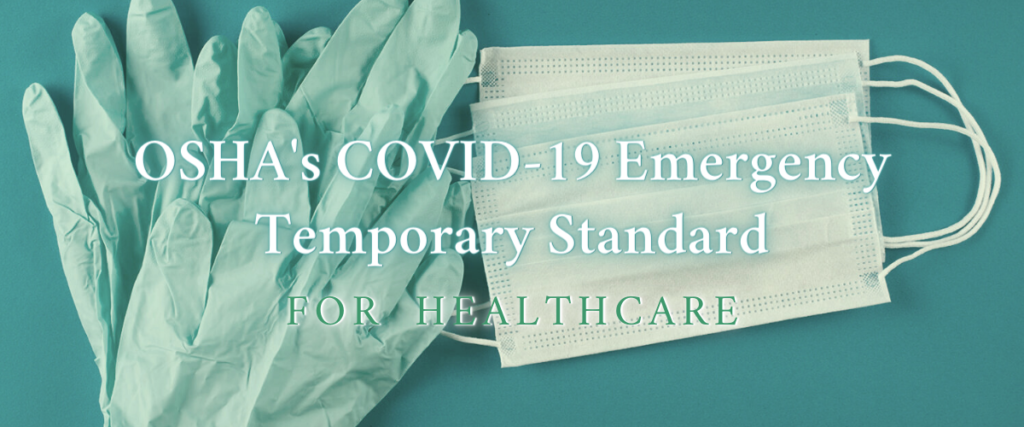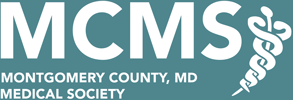
OSHA’s COVID-19 Emergency Temporary Standard for Healthcare
The Department of Labor’s Occupational Safety and Health Administration (OSHA) released an Emergency Temporary Standard (ETS) for Healthcare on Thursday, June 10, 2021. The ETS is meant to protect healthcare and healthcare support service workers from occupational exposure to COVID-19 in settings where people with COVID-19 are reasonably expected to be present.
Is My Practice a Covered Employer?
If your practice is a non-hospital ambulatory care setting AND all non-employees are screened prior to entry AND people with suspected or confirmed COVID-19 are not permitted to enter, then the ETS does NOT apply to your workplace.
As NPR noted, the ETS is not intended to apply to most medical and dental offices, but instead to focus on hospitals, nursing homes, and assisted living facilities. However, if a medical practice is not screening non-employees prior to entry or is treating people with suspected or confirmed COVID-19 at its facility, then the ETS will apply.
OSHA released a flow chart on what defines a covered entity, which all healthcare facilities should review immediately.
Notably, OSHA has also published new guidance and mitigation strategies for other employers along with the ETS.
Compliance Dates
Most provisions of the ETS will go into effect two weeks after it is published in the Federal Register (expected on Monday, June 13 or sooner). Provisions on physical barriers (section i), ventilation (section k), and training (n) will apply after 30 days. OSHA has published additional details on enforcement discretion related to the ETS.
What Are the Requirements of the ETS?
The following are key requirements listed in the ETS. For a more detailed overview, access OSHA’s Fact Sheet.
COVID-19 plan: Develop and implement a COVID-19 plan (in writing if more than 10 employees) that includes a designated safety coordinator with authority to ensure compliance, a workplace-specific hazard assessment, involvement of non-managerial employees in hazard assessment and plan development/implementation and policies and procedures to minimize the risk of transmission of COVID-19 to employees.
Patient screening and management: Limit and monitor points of entry to settings where direct patient care is provided; screen and triage patients, clients, and other visitors and non-employees; implement patient management strategies.
Standard and Transmission-Based Precautions: Develop and implement policies and procedures to adhere to Standard and Transmission-Based precautions based on CDC guidelines.
Personal protective equipment (PPE): Provide and ensure each employee wears a facemask when indoors and when occupying a vehicle with other people for work purposes; provide and ensure employees use respirators and other PPE for exposure to people with suspected or confirmed COVID-19, and for aerosol-generating procedures on a person with suspected or confirmed COVID-19.
Aerosol-generating procedures on a person with suspected or confirmed COVID-19: Limit employees present to only those essential; perform procedures in an airborne infection isolation room, if available; and clean and disinfect surfaces and equipment after the procedure is completed.
Physical distancing: Keep people at least 6 feet apart when indoors.
Physical barriers: Install cleanable or disposable solid barriers at each fixed work location in non-patient care areas where employees are not separated from other people by at least 6 feet.
Cleaning and disinfection: Follow standard practices for cleaning and disinfection of surfaces and equipment in accordance with CDC guidelines in patient care areas, resident rooms, and for medical devices and equipment; in all other areas, clean high-touch surfaces and equipment at least once a day and provide alcohol-based hand rub that is at least 60% alcohol or provide readily accessible handwashing facilities.
Ventilation: Ensure that employer-owned or controlled existing HVAC systems are used in accordance with manufacturer’s instructions and design specifications for the systems and that air filters are rated Minimum Efficiency Reporting Value (MERV) 13 or higher if the system allows it.
Health screening and medical management:
- Screen employees before each workday and shift;
- Require each employee to promptly notify the employer when the employee is COVID-19 positive, suspected of having
COVID-19, or experiencing certain symptoms; - Notify certain employees within 24 hours when a person who has been in the workplace is COVID-19 positive;
- Follow requirements for removing employees from the workplace;
- Employers with more than 10 employees, provide medical removal protection benefits in accordance with the standard to workers who must isolate or quarantine.
Vaccination: Provide reasonable time and paid leave for vaccinations and vaccine side effects.
Training: Ensure all employees receive training so they comprehend COVID-19 transmission, tasks and situations in the workplace that could result in infection, and relevant policies and procedures.
Anti-Retaliation: Inform employees of their rights to the protections required by the standard and do not discharge or in any manner discriminate against employees for exercising their rights under the ETS or for engaging in actions required by the standard.
Requirements must be implemented at no cost to employees.
Recordkeeping: Establish a COVID-19 log (if more than 10 employees) of all employee instances of COVID-19 without regard to occupational exposure and follow requirements for making records available to employees/representatives.
Report work-related COVID-19 fatalities and in-patient hospitalizations to OSHA.
Reference Materials from OSHA
- ETS Regulatory Text (29 CFR 1910, Subpart U)
- ETS Requirements Fact Sheet
- Flowchart: Is your workplace covered by the COVID-19 Healthcare ETS?
- FAQs
Implementing the ETS
- Reporting COVID-19 Fatalities and In-Patient Hospitalizations
to OSHA - The COVID-19 Log
- Employer Notification Tool
- Sample Employee COVID-19 Health Screening Questionnaire
Further Reading
- From The New York Times: OSHA issues a new Covid safety rule, but only for the health care industry
- From NPR: Federal COVID Workplace Safety Rules Are Here. But Only For Health Care Workers
- From Politico: New Covid workplace safety rules snag health care, spare other industries
